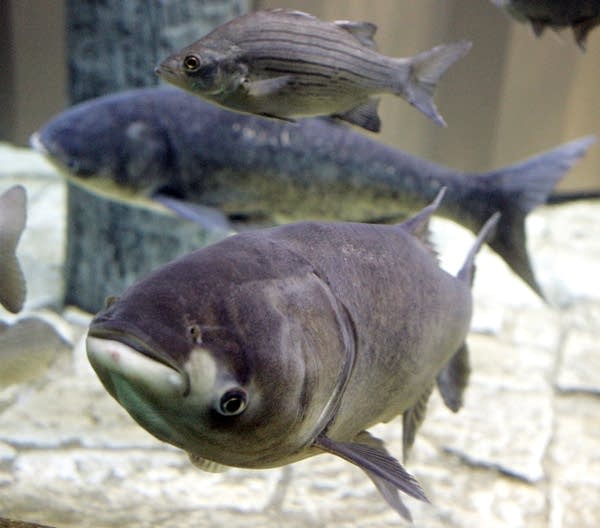Feds to spend $13M to fight Asian carp invasion

Federal officials said Monday they would use $13 million in Great Lakes restoration funds to step up the fight against invasive Asian carp.
Lisa Jackson, head of the Environmental Protection Agency, said the money will be used for engineering projects to prevent the carp from slipping into Lake Michigan near Chicago.
They include closing conduits and shoring up low-lying lands between the Chicago Sanitary and Ship Canal - which leads to the lake - and other waterways.
The ravenous carp have been migrating northward in the Mississippi and Illinois rivers for decades. Scientists say if they get into the Great Lakes, they could gobble up plankton, interrupt the food chain and devastate the $7 billion fishery.
Create a More Connected Minnesota
MPR News is your trusted resource for the news you need. With your support, MPR News brings accessible, courageous journalism and authentic conversation to everyone - free of paywalls and barriers. Your gift makes a difference.
Federal and state officials poisoned a six-mile section of the canal this month to prevent the carp from getting closer to Lake Michigan while an electrical barrier was taken down for maintenance. They have promised to consider other measures.
Michigan officials are preparing a lawsuit demanding at least temporary closure of shipping locks on the canal, part of a roughly 300-mile waterway linking the lake with the Mississippi. That's opposed by tug and barge companies that haul millions of tons of iron ore, coal and other cargo on the waterway.
While debate on a long-term plan continues, the U.S. Army Corps of Engineers will use some of the newly designated funds to block potential bypasses between the sanitary and ship canal and two nearby waterways believed already to have Asian carp: the Des Plaines River and the I&M Canal.
Scientists fear the carp might be washed from those waterways into the sanitary and ship canal above the electrical barrier during flooding caused by heavy rains.
The rest of the money will provide DNA testing in hopes of determining how far the carp have advanced, Army Corps spokeswoman Lynne Whelan said.
Congress this fall appropriated $475 million to kick off a comprehensive restoration of the Great Lakes, including cleanup of contaminated harbors, wildlife habitat improvements and crackdowns on runoff pollution and species invasions.
The $13 million to battle the Asian carp will be drawn from that fund, which President Barack Obama requested.
The fund has "given us what we need to significantly and immediately reduce the risk of Asian carp reaching the Great Lakes and destroying such a valuable ecosystem," Jackson said.
Officials with federal agencies involved in the carp battle met last week with members of Congress who pushed for spending up to $30 million over the next year.
"I want to be clear that our work on this is not done and we'll continue to aggressively work to protect the Great Lakes from this dangerous creature," said Rep. John Dingell, D-Mich. "Allowing the Asian carp into the Great Lakes is simply unacceptable."
Henry Henderson, Midwest director for the Natural Resources Defense Council, said the planned spending was worthwhile but a stopgap measure. Environmental groups want to sever the link between the Great Lakes and Mississippi systems created by engineers more than a century ago.
"We need a permanent solution, not a series of ad hoc barriers," Henderson said.
(Copyright 2009 by The Associated Press. All Rights Reserved.)
